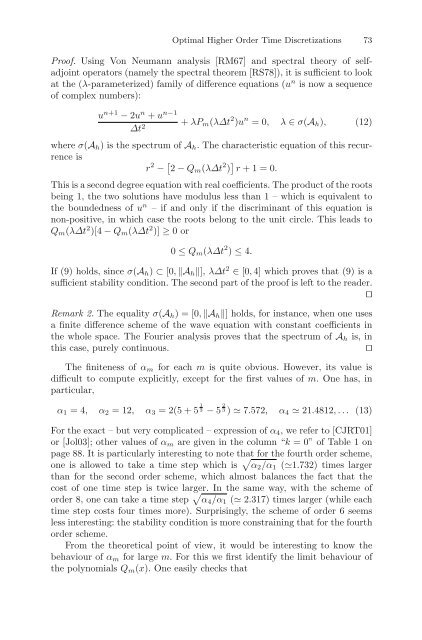Partial Differential Equations - Modelling and ... - ResearchGate
Partial Differential Equations - Modelling and ... - ResearchGate
Partial Differential Equations - Modelling and ... - ResearchGate
You also want an ePaper? Increase the reach of your titles
YUMPU automatically turns print PDFs into web optimized ePapers that Google loves.
Optimal Higher Order Time Discretizations 73<br />
Proof. Using Von Neumann analysis [RM67] <strong>and</strong> spectral theory of selfadjoint<br />
operators (namely the spectral theorem [RS78]), it is sufficient to look<br />
at the (λ-parameterized) family of difference equations (u n is now a sequence<br />
of complex numbers):<br />
u n+1 − 2u n + u n−1<br />
∆t 2 + λP m (λ∆t 2 )u n =0, λ ∈ σ(A h ), (12)<br />
where σ(A h ) is the spectrum of A h . The characteristic equation of this recurrence<br />
is<br />
r 2 − [ 2 − Q m (λ∆t 2 ) ] r +1=0.<br />
This is a second degree equation with real coefficients. The product of the roots<br />
being 1, the two solutions have modulus less than 1 – which is equivalent to<br />
the boundedness of u n – if <strong>and</strong> only if the discriminant of this equation is<br />
non-positive, in which case the roots belong to the unit circle. This leads to<br />
Q m (λ∆t 2 )[4 − Q m (λ∆t 2 )] ≥ 0or<br />
0 ≤ Q m (λ∆t 2 ) ≤ 4.<br />
If (9) holds, since σ(A h ) ⊂ [0, ‖A h ‖], λ∆t 2 ∈ [0, 4] which proves that (9) is a<br />
sufficient stability condition. The second part of the proof is left to the reader.<br />
⊓⊔<br />
Remark 2. The equality σ(A h )=[0, ‖A h ‖] holds, for instance, when one uses<br />
a finite difference scheme of the wave equation with constant coefficients in<br />
the whole space. The Fourier analysis proves that the spectrum of A h is, in<br />
this case, purely continuous.<br />
⊓⊔<br />
The finiteness of α m for each m is quite obvious. However, its value is<br />
difficult to compute explicitly, except for the first values of m. One has, in<br />
particular,<br />
α 1 =4, α 2 =12, α 3 =2(5+5 1 3 − 5<br />
2<br />
3 ) ≃ 7.572, α4 ≃ 21.4812,... (13)<br />
For the exact – but very complicated – expression of α 4 , we refer to [CJRT01]<br />
or [Jol03]; other values of α m are given in the column “k = 0” of Table 1 on<br />
page 88. It is particularly interesting to note that for the fourth order scheme,<br />
one is allowed to take a time step which is √ α 2 /α 1 (≃1.732) times larger<br />
than for the second order scheme, which almost balances the fact that the<br />
cost of one time step is twice larger. In the same way, with the scheme of<br />
order 8, one can take a time step √ α 4 /α 1 (≃ 2.317) times larger (while each<br />
time step costs four times more). Surprisingly, the scheme of order 6 seems<br />
less interesting: the stability condition is more constraining that for the fourth<br />
order scheme.<br />
From the theoretical point of view, it would be interesting to know the<br />
behaviour of α m for large m. For this we first identify the limit behaviour of<br />
the polynomials Q m (x). One easily checks that
















